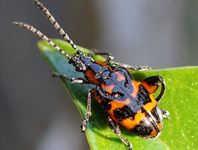Abstract
This study describes and illustrates the morphology of the second juvenile stage of the blue-fingered burrowing crayfish Parastacus caeruleodactylus. One female carrying 20 juveniles was collected in January 2019 from a swamp forest in the municipality of Dom Pedro de Alcântara, state of Rio Grande do Sul, southern Brazil. Juveniles were dissected and the appendages were mounted in slides. The general morphology and the pattern of attachment of the second juvenile stage of P. caeruleodactylus correspond to that reported for other parastacids. The main differences among the co-generic species are related to the number of articles in the flagella of the antennae, the number of spines in the antennal scale, the number of setae in the articles of the appendages, the number of teeth in the mandible molar and incisor processes, the absence of segmentation in the exopod flagellum of the maxillipeds and the number of teeth in the crista dentata of the ischium of maxilliped 3.
References
Barcelos, D.F. (2007) Morfologia externa de Parastacus defossus Faxon, 1898 (Crustacea, Decapoda, Parastacidae). Master Dissertation, Programa de Pós-Graduação em Biologia Animal, Universidade Federal do Rio Grande do Sul, 99 pp.
Gurney, R. (1935) The mode of attachment of the young in the crayfishes of the families Astacidae and Parastacidae. Annals and Magazine of Natural History, Series 10, 16, 553–555.
https://doi.org/10.1080/00222933508655082
Hamr, P. & Richardson, A.M.M. (1994) The life history of Parastacoides tasmanicus tasmanicus Clark, a burrowing freshwater crayfish from south-west Tasmania. Australian Journal of Marine and Freshwater Research, 45, 455–470.
https://doi.org/10.1071/MF9940455
Huber, A.F., Ribeiro, F.B. & Araujo, P.B. (2017) New endemic species of freshwater crayfish Parastacus Huxley, 1879 (Crustacea: Decapoda: Parastacidae) from the Atlantic forest in southern Brazil. Nauplius, 26, e2018015.
https://doi.org/10.1590/2358-2936e2018015
Miranda, I., Gomes, K.M., Ribeiro, F.B., Araujo, P.B., Souty-Grosset, C. & Schubart, C.D. (2018) Molecular systematics reveals multiple lineages and cryptic speciation in the freshwater crayfish Parastacus brasiliensis (von Martens, 1869) (Crustacea: Decapoda: Parastacidae). Invertebrate Systematics, 32, 1265–1281.
https://doi.org/10.1071/IS18012
Noro, C.K. & Buckup, L. (2008) Estrutura populacional e biologia reprodutiva de Parastacus defossus (Crustacea: Decapoda: Parastacidae). Revista Brasileira de Zoologia, 25 (4), 624–629.
https://doi.org/10.1590/S0101-81752008000400007
Noro, C.K., Buckup, L. & Bond-Buckup, G. (2005) The juvenile stages of Parastacus brasiliensis (von Martens, 1869) (Crustacea, Decapoda, Parastacidae). Journal of Natural History, 39 (21), 1851–1873.
https://doi.org/10.1080/00222930400005724
Ribeiro, F.B., Buckup, L., Gomes, K.M. & Araujo, P.B. (2016) Two new species of South American freshwater crayfish genus Parastacus Huxley, 1879 (Crustacea: Decapoda: Parastacidae). Zootaxa, 4158 (3), 301–324.
http://doi.org/10.11646/zootaxa.4158.3.1
Ribeiro, F.B., Huber, A.F., Schubart, C.D. & Araujo, P.B. 2017. A new species of Parastacus Huxley, 1879 (Crustacea, Decapoda, Parastacidae) from a swamp forest in southern Brazil. Nauplius, 25, e2017008.
https://doi.org/10.1590/2358-2936e2017008
Richardson, A.M.M. (2007) Behavioral Ecology of Semiterrestrial Crayfish. In: Duff, J.E. & Thiel, M. (Eds.), Evolutionary Ecology of Social and Sexual Systems: Crustaceans as Model Organisms. Oxford University Press, Oxford, pp. 319–338.
https://doi.org/10.1093/acprof:oso/9780195179927.003.0015
Ringuelet, R. (1949) La morfología y el mecanismo de sujeción de las crías de Parastacus agassizi Faxon. Instituto del Museo de la Universidad Nacional de La Plata, 55–59.
Rudolph, E.H. (2013) Parastacus pugnax (Poeppig, 1835) (Crustacea, Decapoda, Parastacidae): conocimiento biológico, presión extractiva y perspectivas de cultivo. Latin American Journal of Aquatic Research, 41 (4), 611–632.
https://doi.org/103856/vol41-issue4-fulltext-1
Rudolph, E.H. & Iraçabal, J. (1994) Desarrollo embrionario y postembrionario del camarón de río Samastacus spinifrons (Philippi, 1882) (Decapoda, Parastacidae). Boletin de la Sociedad de Biología de Concepción, 65, 43–49.
Rudolph, E.H. & Ríos, O.J. (1987) Desarrollo ontogenético del camarón de las vegas Parastacus pugnax (Poeppig, 1835), en condiciones de laboratoório. Biota, Chile, 3, 45–48.
Rudolph, E.H. & Rojas, C.S. (2003) Embryonic and early postembryonic development of the burrowing crayfish, Virilastacus araucanius (Faxon, 1914) (Decapoda, Parastacidae) under laboratory conditions. Crustaceana, 76 (7), 835–850.
https://doi.org/10.1163/15685400360730615
Rudolph, E. & Zapata, L. (1986) Desarrollo embrionario y postlarval del camarón de las vegas Parastacus nicoleti (Philippi, 1882) en condiciones de laboratorio. Biota, 2, 37–50.
Scholtz, G. (1995) The attachment of the young in the New Zealand freshwater crayfish Paranephrops zealandicus (White, 1847) (Decapoda, Astacida, Parastacidae). New Zealand Natural Sciences, 22, 81–89.
Silva-Castiglioni, D., López Greco, L., Oliveira, G.T. & Bond-Buckup, G. (2008) Characterization of the sexual pattern of Parastacus varicosus (Crustacea: Decapoda: Parastacidae). Invertebrate Biology, 127 (4), 426–432.
https://doi.org/10.1111/j.1744-7410.2008.00144.x
Suter, P.J. (1977) The biology of two species of Engaeus (Decapoda: Parastacidae) in Tasmania II.* Life history and larval development, with particular reference to E. cisternarius. Australian Journal of Marine and Freshwater Research, 28, 85–93.
https://doi.org/10.1071/MF9770085
Thomas, W.J. (1970) The setae of Austropotamobius pallipes (Crustacea: Astacidae). Journal of Zoology, 160, 91–142.
https://doi.org/10.1111/j.1469-7998.1970.tb02899.x
Vogt, G. (2013) Abbreviation of larval development and extension of brood care as key features of the evolution of freshwater Decapoda. Biological Reviews, 88 (1), 81–116.
https://doi.org/10.1111/j.1469-185X.2012.00241.x

